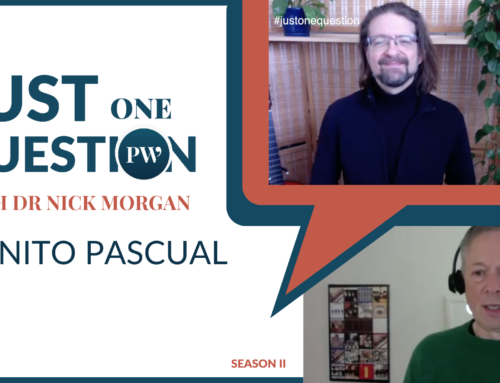How do you create a great story for the purposes of public speaking? There are a couple of ways to think about it.
My favorite structure for a persuasive speech is the problem-solution structure that I’ve blogged about before. You can either hold to that structure, and tell stories at various points along the way, as examples and supporting evidence and so on, or you can treat the whole speech as a story.
In either case, think of your stories as having three acts. The first act presents an idea or a situation that will engage the audience (Romeo meets Juliet and falls in love). It’s best if this idea or situation is one that, once it has happened or been told, cannot be undone. (Romeo cannot ‘unmeet’ Juliet.) If you give your audience some information at the beginning of your speech that they don’t know, it has the same effect. Our customer base has been eroding for the last 16 quarters, and just today I learned that it’s official – we’re now down for 17 quarters. We can’t afford to go on like this….
Needless to say, it should be information that is of interest to them – it should be about a problem they have.
The second act raises the stakes on the earlier idea or situation. (Romeo marries Juliet despite the feud between the two families.) Once again, it should be something that cannot easily be undone. If we have another down quarter, we’re going to have to close manufacturing plants in Chicago and Ohio.
The third act precipitates a resolution, either favorable or unfavorable, by posing a question that must be resolved. (Romeo kills Tybalt in a duel, thus resulting in his banishment. Will Romeo and Juliet live happily ever after? Answer: no.) To turn things around, I’m starting a new product line, code name Lemmings, that will excite customers once again and bring them flocking back to our stores. Just as no one in the play Romeo and Juliet ever literally asks the resolving question out loud, you don’t have to in your speech. You do have to resolve it, and the best way is to get your audience to undertake some action to enlist them in your persuasive moment. I've put prototype Lemmings underneath your chairs. I'd like you now to please take them out of their boxes and try them out.
Just as the rest of Romeo and Juliet fills in around these key moments with scenes that explore the consequences of these interesting, fateful actions, your speech should too.
That’s the basic structure of a good story. Next time I’ll talk about the fundamental stories and the archetypes and how you can use them to make your presentations more powerful.








Leave A Comment